Spotlight What Matters Most in Your Customer Conversations
Spotlight Summaries are here to shine a light on key trends in your conversations. This new feature analyses multiple interactions
We all know that good customer service is important, but what does good customer service actually mean? In this post we break down the results of a comprehensive cross-industry study of digital customer service channels to understand what 'good customer service' actually means.

We all know good customer service is important. Important for a company’s brand, important for customer retention, important for your ability to attract new customers. But what exactly is ‘good customer service’ and how can you achieve it?
To figure this out, EdgeTier conducted a cross-industry study evaluating the customer service departments of over 200 companies. As one of the best measures of customer service quality is the length of time a company is prepared to leave a customer wait for service, response times were analysed. Companies who are prepared to leave a customer wait for hours or days for a response to a query do not prioritise their customers or their customers’ time. Companies who actively seek to differentiate with customer service will invest in people, technology and processes to ensure that their customers are delivered timely, accurate responses to any query.
EdgeTier’s study evaluates the digital customer service capabilities and response times of contact centres across a range of industries in the UK and Ireland. The two most dominant digital channels were evaluated, namely email and chat-based channels.
Before we get to the results of the study, let’s firstly take a brief look at two big questions; 1) Why is good customer service important, and 2) What do people expect from a customer service organisation?
Quite simply, good customer service translates into more money for your company. Good customer service drives higher customer retention and attracts people to your company. According to a 2017 study by Microsoft, 96% of people indicated that customer service plays a role in their choice and loyalty of a brand, while 56% of people ceased doing business with a brand due to poor customer service.
Additionally, as reported in the Harvard Business Review, companies at the top of their industries in Net Promoter Scores (NPS) or satisfaction rankings grow revenues roughly 2.5 times as fast as their industry peers and deliver two to five times the shareholder returns over a 10 year period. Good customer service increases both loyalty and revenue with customers willing to spend 17% more to do business with companies that deliver excellent customer service.

McKinsey also highlight the importance of good customer care, stating that personalisation at scale delivered through customer service can drive between 5% and 15% revenue growth for companies.
These are simply staggering numbers, yet are indicitive of a population that expects and rewards good quality customer service. So, next question. What is it that consumers expect from customer service teams?
The short answer to this is that consumers expect high quality answers fast. Faster than ever before.
Expectations on the level of service provided by customer care teams are continuously increasing. 54% of people say that they have higher expectations for customer service today than they had one year ago. Younger generations are more demanding, with 66% of 18-34 year olds saying they have higher expectations today than one year ago. This trend is not reversing any time soon.
Let’s dig a little deeper into the specifics of what consumers demand from email and chat customer support teams. Firstly, let’s look at email, where there is some bad news for any companies currently targeting a 24 hour email SLA….
Some of you may remember a time when email was considered a slow channel. Fire off an email and you’ll probably get a response in a day or so. It’s pretty clear however, that those days are over. Customers measure email response times in hours rather than days and are treating email more and more like an online channel. A whopping 87% of people expect an email response time in under 1 day, with 30% of consumers expecting an email response in an hour or less.
So if your company has a 24 hour SLA target for email, be aware that even if you hit that SLA, you are still letting down the majority of your customers.
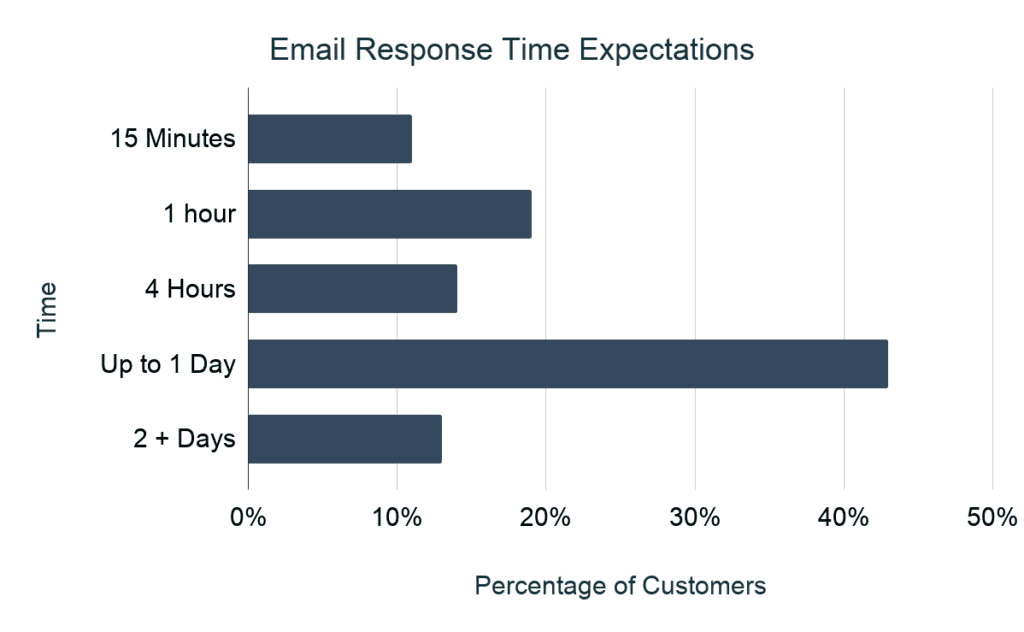
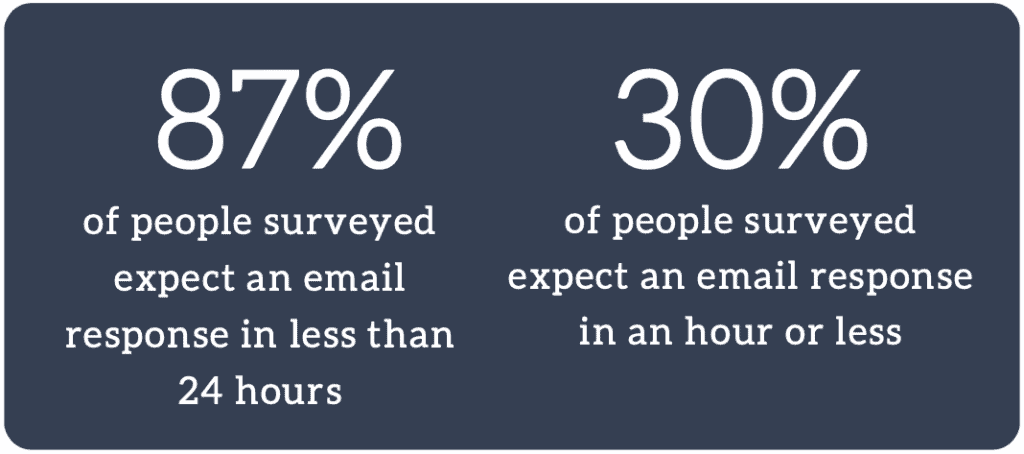
Secondly, let’s take a look at expectations on chat. Customers expect the live-chat process to be a quick and easy route to resolving a query. Direct connection to a human agent is expected almost instantaneously on chat. The majority of every single age demographic expect chats to be connected to a live agent in under 1 minute, in fact older generations are more demanding than younger ones (except for those mellow 65+ year olds!).
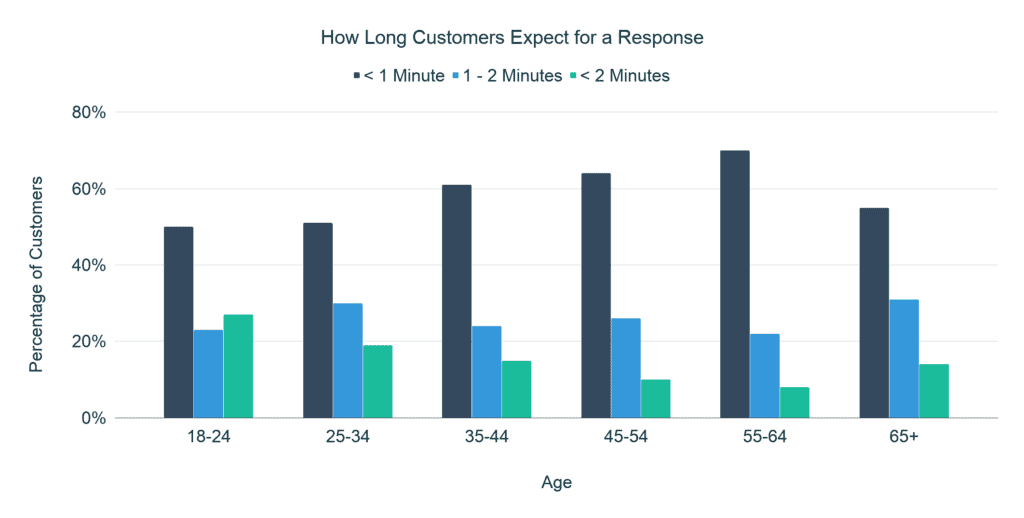
What’s more, consumers will quickly abandon chats if they are not responded to. Over 50% of people who answered the survey will abandon a chat if they are waiting over 1 minute, while over 84% of people claim they will abandon a chat if they have not received a response within 2 minutes.
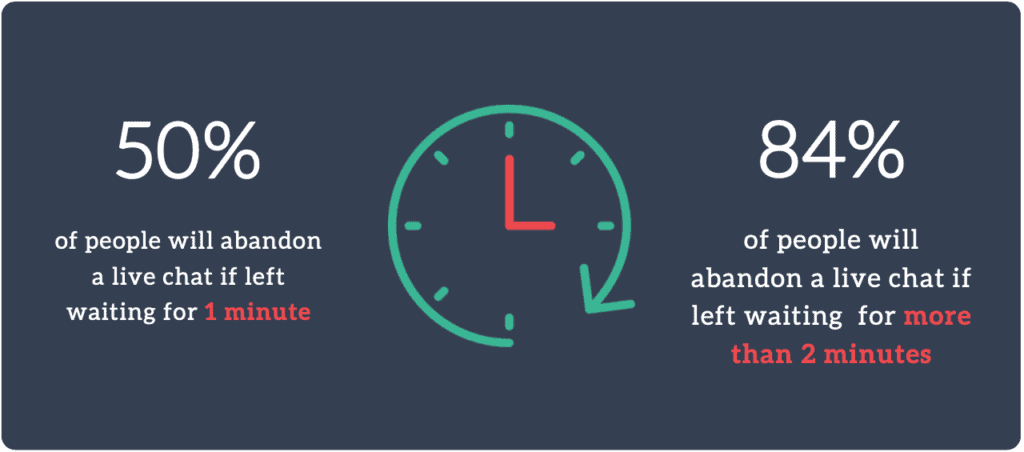
So overall, yes, consumers are demanding of customer service teams. But are their expectations being met? Do companies actually deliver good customer service? Are customers getting what they want?
Ok, so let’s delve into some of that data and see what customers are actually getting from customer care teams. Firstly, in terms of the channels offered; while adoption varies per industry, in general email is the most common digital support channel with 90% of companies studied offering email support. 33% of companies studied currently offer live-chat support.
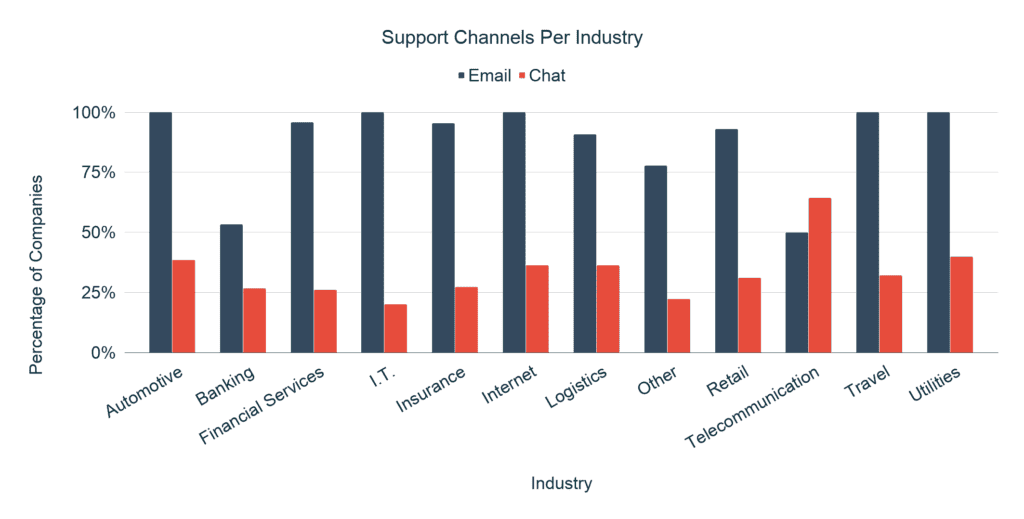
The cross-industry email response times for all of the companies in this study are outlined in the figure below, with all companies who responded in greater than 48 hours grouped together in the final column.

In total, 15% of all companies responded to emails within one hour, while 22% of companies responded in less than 2 hours. 55% of companies responded to email queries within 24 hours, while 39% of companies took longer than 48 hours to respond, or did not respond to the query at all. Overall, the median response time was 19.6 hours, however when taking business hours into account (8am to 8 pm), the median response time for emails was 7.6 hours.

The email response time results show that the majority of customer service companies are not meeting the expectations of consumers. 30% of customers expect to receive an email response within 1 hour of sending their query, and currently only 14% of companies meet that expectation. However, a number of companies providing high-quality email support emerged from the analysis. 7% of companies responded to a customer email query within 15 minutes. These 7% of companies meet the cross-industry criteria for best-in-class respose times over email.
A breakdown of average (median) response times per industry is shown below. There is a relatively large distribution of response times, with average response times in different industries varying from under 2 hours (Internet) to 36 hours (Travel). Travel, Logistics and Insurance companies score particularly badly, while Internet, banking and telecommunications companies leading the way in terms of response times with average response times of 1.4 hours, 3.8 hours and 6.6 hours respectively.
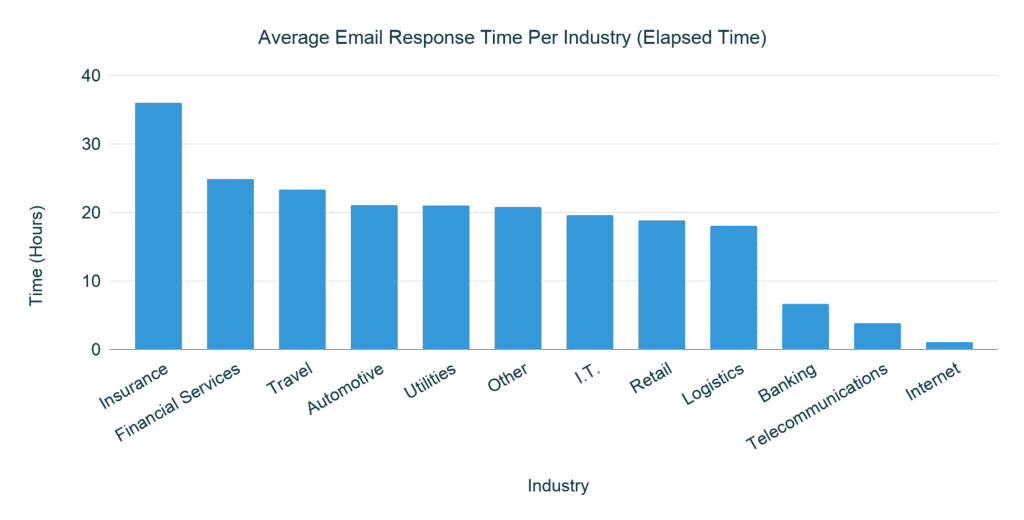
When taking business hours into account (assuming 8am to 8pm as business hours), the response times can be seen below. Overall the average response time in business hours is 7.6 hours.
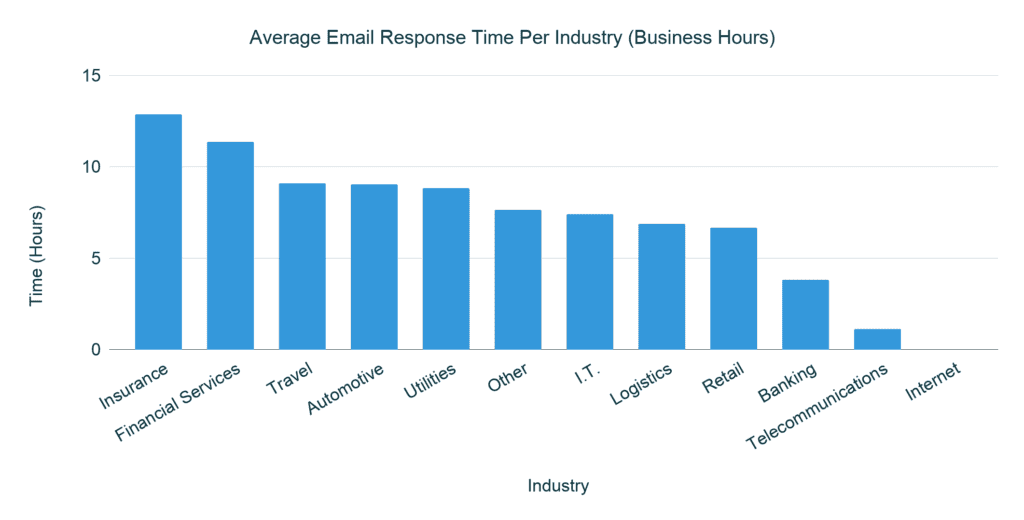

Turning to chat and starting on a positive. 8% of chats were instantly connected to a human agent with no wait time once the request was initiated. A further 47% of companies connected to a human agent within 1 minute of the chat request being sent, with a further 8% of companies responding within 2 minutes.
From these figures, we can see that chat response times are more in line with customer expectations than email response times. The expected response time for a chat is less than one minute, and 55% of all companies meet this expectation. However, 36% of companies have answer times greater than 2 minutes. To put the two minute answer time in context, 84% of people say they will abandon a chat if it is not answered within two minutes.

Dividing by industry, IT is the poorest performing industry, with a median response time of over 4 minutes. Travel is also a poor performer, with an average response time of 3 minutes. Seven of the industries studied come with average response times of less than a minute, showing general cross-industry support of responsive chat support.
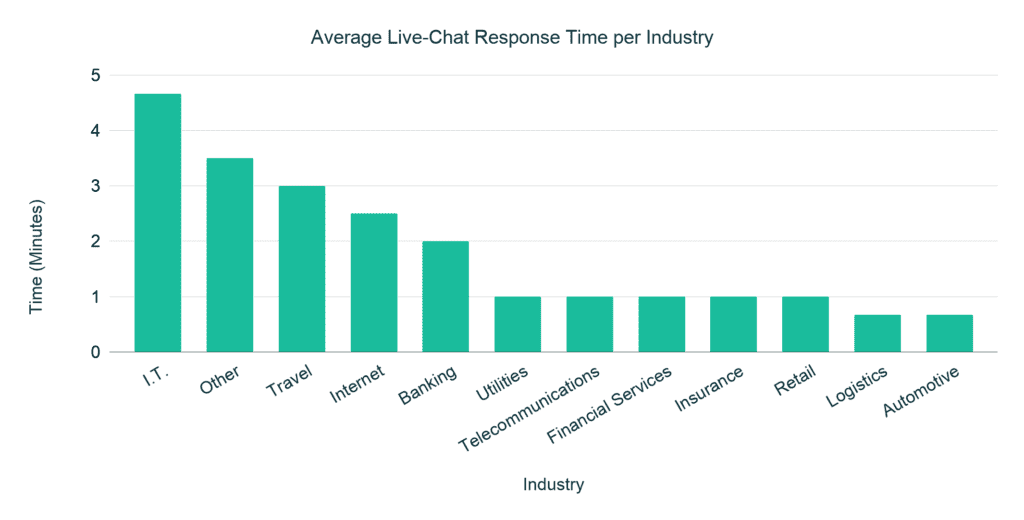
Across all industries, if you want to deliver good customer service, you need to be responsive to customers. But how fast is good enough? To understand that, we can look at the best-in-class companies (the top 10%) across all industries. In order to be in the top 10% of companies, you need to answer emails in under 31 minutes, and connect chats to agents in under 20 seconds.
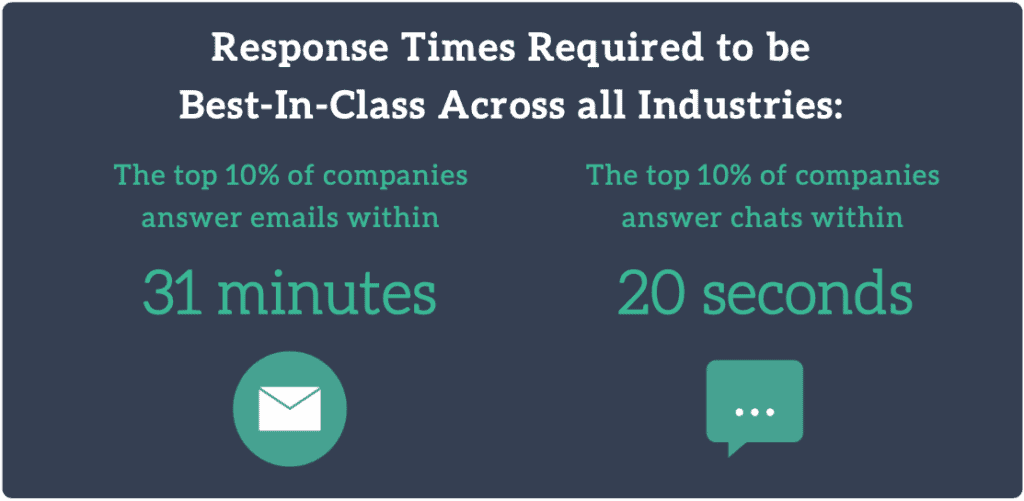
Targetting an email response in 31 minutes and a chat connection in 20 seconds may represent a shift in approach to many customer service centres, where long queues are the norm. Clearly, the days of 24 hour email SLAs representing high-quality are over, with consumers and companies alike striving towards response times that are measured in a number of hours, if not minutes.
Chat is viewed by consumers as an instant channel for feedback, and leading companies are delivering on that viewpoint, with top companies connecting customers to agents virtually instantly.
Unfortunately, failing to meet these high expectations is quite damaging, particularly given that many of the companies in this study are operating in commoditised industries where customer service is one of the few differentiators available. It is infeasible for many companies to achieve these targets and remain profitable with their current approach to customer service. Throwing more people into a customer service team simply isn’t possible for many companies. In this case, changes in technology and processes are required to deliver good customer care.
If you would like to receive a complimentary copy of the full report, which contains a more detailed breakdown of the figures as well as an more in-depth industry focus, please fill in the form below and a member of the EdgeTier team will send you on the report.
Also, if you would like to learn about how EdgeTier’s AI and Automation technology allows customer support teams to increase efficiency, reduce wait times while also increasing the quality of customer interactions, you can contact a member of the team with the same form.
Spotlight Summaries are here to shine a light on key trends in your conversations. This new feature analyses multiple interactions
We’ve just added confusion detection to our emotion analysis tools. Now, you can easily spot when customers are confused, allowing
Discover how EdgeTier’s latest AI-powered updates can optimise your contact centre, including anomaly detection summaries, agent QA, and custom charts.
"We now have highly detailed understanding of agent performance, not just on key agent metrics, but also on how customers react to our agents and the emotions of our customers feel when talking to our team."
"The anomaly feature is a game changer for us. It’s highly accurate and has helped us identify customer issues, agent errors, and even fraud that would have taken us longer to catch."
"EdgeTier is really shining when it comes to responsible gambling. We can proactively track critical issues and take actions, reducing human error."



Let us help your company go from reactive to proactive customer support.
Unlock AI Insights